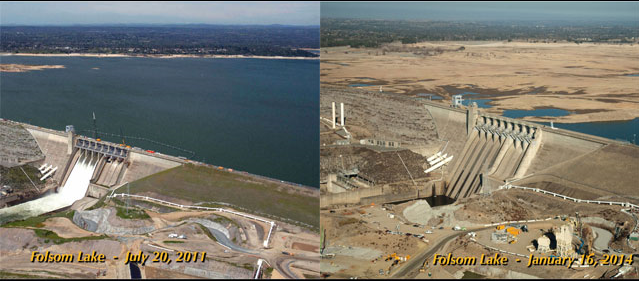Human-Environment Interactions
One of the central contributions of the geographic discipline is its examination of the interactions between social and ecological systems. Thinking about these interactions requires addressing several key questions.
The first question is how does the natural environment shape, control, and constrain human systems? One way this is understood is in terms of natural hazards, which are natural events that disrupt human activity. For example, the ongoing and persistent drought in California (2012-Present, Figure 1.5) has resulted in devastating effects on ecosystems and human society. The threat of wildfire is greatly increased by the continued dryness and wildlife and people are suffering from severe water shortage. The dry conditions also have taken a heavy toll on agriculture, tourism, and recreational industries.

The second key question about human-environment interactions is how human decision-making and processes shape and change the natural environment, including ecosystems, river systems, vegetation, and climate. Humans have caused such significant environmental change that Nobel Prize-winning scientist Paul Crutzen suggested in 2000 that we have entered a new era known as the Anthropocene.
There is great concern about whether social and ecological systems can coexist in a sustainable manner. This has helped advance the concept of sustainability, which seeks to understand how human activities can exist without disrupting the ability of natural ecosystems to function. The sustainability concept will appear in various modules for this course, including coupled human-environmental systems, ethics and democracy, development, and individual responsibility. You will work through how sustainability is understood and the different ways that it is addressed.
An important consideration to sustainability is the concept of governance. Studies of governance consider how people make decisions and how they are constrained by external forces and structures to limit their range of options. An understanding of human-environment interactions attends to environmental governance in the ways that the ability of people to make decisions regarding the natural environment is shaped in part by external factors. As an example of this, the farmer in Brazil that we already discussed participates in governance decision-making with other stakeholders (the Brazilian government, other community members, etc.), state policies, and markets. The decisions that result in terms of transforming the natural environment are influenced by the governance mechanisms that shape the range of options available to particular actors. Environmental governance, which is in essence how natural resources are interpreted and managed by different stakeholders, connects to questions of sustainability. For example, one way of governing natural resources is through common property systems whereby individual actors are allowed access but with certain restrictions. Another example is exclusionary protected areas that restrict the movement of human populations and extraction of natural resources. These are two types of environmental governance strategies that have different impacts on social and ecological systems.
Finally, many of these discussions include concerns for ethics, as they involve how we prioritize human needs at the expense of non-human needs, how some human populations benefit from industrial development more than others, and what are the ecological costs of human-driven environmental change. The next course module, Coupled Human-Environment Systems, addresses these questions in more detail.
